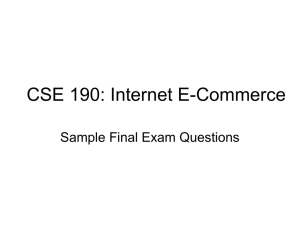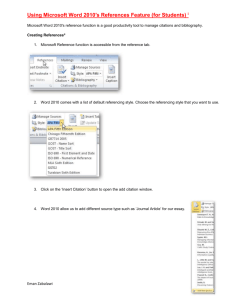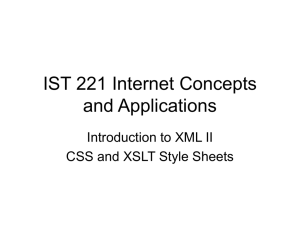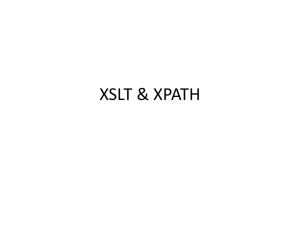Extensible Stylesheet Language for Transformations (XSLT)
advertisement
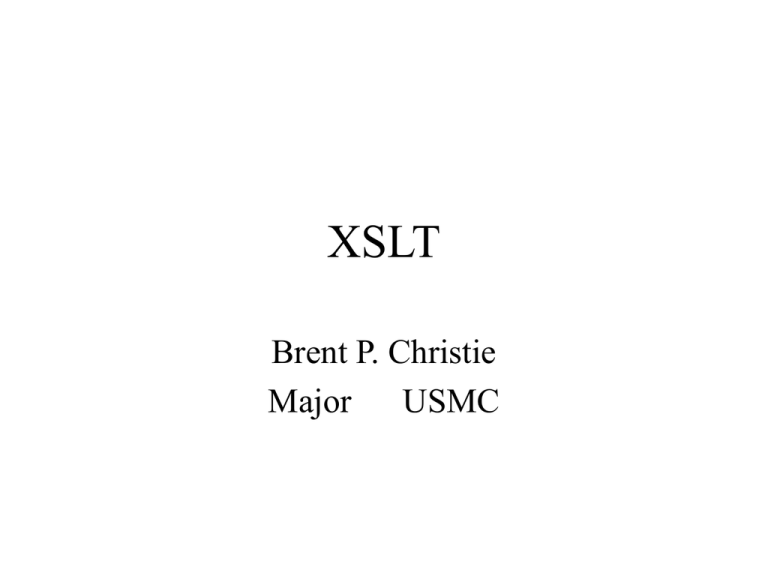
XSLT
Brent P. Christie
Major USMC
XSLT Overview
What is XSLT?
– XSL is the Extensible Style Language.
– It has two parts: the transformation language and the
formatting language.
– In this lecture we are concerned with XSL
transformations, or XSLT.
• The formatting language will be discussed in a separate brief.
– XSLT provides a syntax for defining rules that
transform an XML document to another document.
• For example, to an HTML document.
– An XSLT “style sheet” consists primarily of a set of
template rules that are used to transform nodes
matching some patterns.
XSLT Overview
Example of XML document
<?xml version=”1.0”?>
<?xml-stylesheet type=”text/xml” href=”planets.xsl”?>
<PLANETS>
<PLANET>
<NAME>Mercury</NAME>
<MASS UNITS=”(Earth = 1)”>.0553</MASS>
<DAY UNITS=”days”>58.65</DAY>
<RADIUS UNITS=”miles”>1516</RADIUS>
<DENSITY UNITS=”(Earth = 1)”>.983</DENSITY>
<DISTANCE UNITS=”million miles”>43.4</DISTANCE><!--At perihelion-->
</PLANET>
XSLT Overview
XML document example con’t
<PLANET>
<NAME>Venus</NAME>
<MASS UNITS=”(Earth = 1)”>.815</MASS>
<DAY UNITS=”days”>116.75</DAY>
<RADIUS UNITS=”miles”>3716</RADIUS>
<DENSITY UNITS=”(Earth = 1)”>.943</DENSITY>
<DISTANCE UNITS=”million miles”>66.8</DISTANCE><!--At perihelion-->
</PLANET>
<PLANET>
<NAME>Earth</NAME>
<MASS UNITS=”(Earth = 1)”>1</MASS>
<DAY UNITS=”days”>1</DAY>
<RADIUS UNITS=”miles”>2107</RADIUS>
<DENSITY UNITS=”(Earth = 1)”>1</DENSITY>
<DISTANCE UNITS=”million miles”>128.4</DISTANCE><!--At perihelion-->
</PLANET>
</PLANETS>
XSLT Overview
Example of a style sheet planet.xsl
<?xml version=”1.0”?>
<xsl:stylesheet version=”1.0” xmlns:xsl=”http://www.w3.org/1999/XSL/Transform”>
<xsl:template match=”PLANETS”>
<HTML>
<xsl:apply-templates/>
</HTML>
</xsl:template>
<xsl:template match=”PLANET”>
<P>
<xsl:value-of select=”NAME”/>
</P>
</xsl:template>
</xsl:stylesheet>
XSLT Overview
Result
<HTML>
<P>Mercury</P>
<P>Venus</P>
<P>Earth</P>
</HTML>
XSLT Overview
The xml-stylesheet element in the XML instance references an XSL
style sheet.
In general, children of the stylesheet element in a stylesheet are
templates.
A template specifies a pattern; the template is applied to nodes in the
XML source document that match this pattern.
– Note: the pattern “/” matches the root node of the document, we will see
this later
In the transformed document, the body of the template element
replaces the matched node in the source document.
In addition to text, the body may contain further XSL terms, e.g.:
– xsl:value-of extracts data from selected sub-nodes.
XSLT Overview
We have an XML document and the style sheet (or rules)
to transform it. So, how do you transform the document?.
You can transform documents in three ways:
– In the server. A server program, such as a Java servlet, can use a
style sheet to transform a document automatically and serve it to
the client. Example, XML Enabler, which is a servlet that you’ll
find at XML for Java Web site,
www.alphaworks.ibm.com/tech/xml4j
– In the client. An XSL-enabled browser may convert XML
downloaded from the server to HTML, prior to display. Currently
Internet Explorer supports a subset of XSLT.
– In a standalone program. XML stored in or generated from a
database, say, may be “manually” converted to HTML before
placing it in the server’s document directory.
In any case, a suitable program takes an XML document as
input, together with an XSLT “style-sheet”.
Format of Style Sheet
You guessed it, XSLT style sheet is itself an XML document.
We will be using the XSLT elements from the namespace
http://www.w3.org/1999/XSL/Transform for this brief
– As a matter of convention we use the prefix xsl: for this namespace.
The document root in an XSLT style sheet is an xsl:stylesheet element,
e.g.:
<xsl:stylesheet version="1.0"
xmlns:xsl="http://www.w3.org/1999/XSL/Transform" >
...
</xsl:stylesheet>
– A synonym for xsl:stylesheet is xsl:transform.
Several kinds of element can be nested inside xsl:stylesheet, but by far
the most important is the xsl:template element.
The xsl:template element
When you match or select nodes, a template tells the XSLT
processor how to transform the node for output
So all our templates will have the form:
<xsl:template match=“pattern”>
template body
</xsl:template>
The pattern is an Xpath expression describing the nodes to
which the template can be applied.
The processor scans the input document for nodes
matching this pattern, and replaces them with the text
included in the template body.
In a nutshell, this explains the whole operation of XSLT.
XPATH
The XML Path Language, or XPath, is a language for addressing parts
of an XML document.
The patterns and other node selections appearing in XSLT rules are
represented using XPath syntax.
– Including the match element of xsl:template or the select element of
xsl:value-of.
We’ve seen that you can use the match attribute to find nodes by
name, child elements(s), attributes. Can even find a descendant.
XPath does all this and more with the select attribute.
– Finding nodes by parent or sibling elements, as well as much more
involved tests.
More of a true language than the expressions you can use with match
attribute
– Return not only lists of nodes, but also Boolean, string, and numeric
values
XPath
It is an essential part of XSLT, and also XPointer
(as wel as being used in XML schema).
In simple cases an XPath expression looks like a
UNIX path name, with nested directory names
replaced by nested element names:
– “/” is the root element of a document
– expressions may be absolute (relative to the root) or
relative to some context node
Types of XPath expressions
Xpath expressions evaluate to one of four possible types of
thing:
– A node-set: a collection of nodes in the XML document. See
below for the description of “node”.
– A boolean value: true or false.
– A number: always represented internally as 64-bit IEEE 754
floating-point double-precision format, although they may be
written and used as an integer.
– A string.
In the end we are interested in Xpath expressions that
evaluate to a node-set, although other expression types will
appear.
Xpath Node
XSL transformations accept a document tree as input and
produce a tree as output. From the XSLT point of view,
documents are trees built of nodes, and there are seven types of
nodes that can appear in a node-set; here are those nodes, and
how XSLT processors treat them:
Node
Document root
Attribute
trimmed
Comment
Description
Is the very start of the document, “/”
Holds the value of an attribute after entity
references have been expanded and
surrounding whitespace has been
Holds the text of a comment, not including <!-and -->
Element
Consists of all character data in the element,
which includes character data in any
of the
children of the element
Namespace
Holds the namespace’s URI
Processing instruction Holds the text of the processing instruction,
which does not include <? and ?>
Location paths
The most important kind of Xpath expression—the one
that gives XPath its name—is the location path.
– absolute location path – path from the root node
– relative – starting with current node, called context node.
In general a location path consists of a series of location
steps separated by the slash “/”. Made up of
– axis, a node test, and zero or more predicates.
As noted earlier, the most common example of a location
step—analogous to a UNIX directory name—is an XML
element name.
Actually this common case is an example of what is called
abbreviated syntax.
To be systematic, we will describe the general,
unabbreviated syntax for location paths first
Parts of a location step
An individual location step has three logical parts:
– The axis—a keyword which, loosely speaking, describes the
“dimension” this location step takes us into.
• Simple examples are child and attribute which, respectively, say
that this step enters the set of children or the set of attributes of an
element.
– A node test—this is typically an element or attribute name,
selecting within the chosen axis. It may also, less specifically, be a
node type.
– Zero or more predicates, which use arbitrary XPath expressions to
further refine the set of selected nodes.
The unabbreviated syntax for a location step is:
axis :: node-test [predicate1] [predicate2] . . .
Axes
Any location step starts from some context node; the axis
is relative to this node.
The available axes are:
–
–
–
–
–
–
–
–
–
–
child—contains the children of the context node.
descendent—contains children and all descendents of children.
parent—contains the parent of the context node.
ancestor—contains parent of the context node and ancestors of parent. All
the way back to and including root node.
attribute—contains the attributes of the context node.
following—all following element nodes, in document order.
preceding—all preceding element nodes, in document order.
following-sibling, preceding-sibling—elements at the same syntactic
level.
namespace—contains namespace nodes of context node.
self, descendent-or-self, ancestor-or-self
The NodeTest
After choosing the axis, we refine the selection with a node
test.
The most common cases for a the node-test field are likely
to be:
– an element or attribute name, selecting nodes in the axis with the
given name, or
– the wildcard, “*”, selecting all nodes of the “principal type” for
this axis (typically, all element nodes, or all attribute nodes if axis
is attribute).
The node-test field may also be a node type expression:
– comment(), text(), processing-instruction(), node()
– Optionally, the processing-instruction() function may include a
literal string specifying a particular type of instruction.
Predicates
The node test is optionally followed by a series of
predicate expressions.
Each expression appears in []s.
Syntax of the expressions will be briefly discussed later.
Some examples appear in the next few slides.
The predicates are computed successively to further filter
the set of selected nodes—after each predicate is applied,
the selected node set is reduced to exclude those elements
for which the expression evaluates to false.
Following examples are taken from the XML Path
Language specification.
Example location paths
child :: para
– para element children of the context node
child :: *
– All element children of the context node
child :: text()
– All text node children of the context node
child :: node()
– All children, regardless of node type
attribute :: name
– The name attribute of the context node
attribute :: *
– All attributes of the context node
decendent :: para
– para element descendents of the context node
ancestor :: div
– div element ancestors of the context node
More complex examples
child :: chapter/descendent :: para
– para element descendents of chapter element children of the context node.
child :: */child :: para
– All para element grandchildren of the context node.
/descendent :: para
– All para elements in this document.
child :: para [position() = 1]
– First para element child of the context node.
child :: para [position() = last()]
– Last para element child of the context node.
child :: para [position() > 1]
– All para element children of the context node, except the first.
/child :: doc/child :: chapter [position() = 5]/child :: section
– section elements of 5th chapter element of root doc element.
child :: para [attribute :: type = ‘warning’] [position() = 5]
– 5th para child of context node having type attribute value “warning”.
Predicate expressions
The axis in a location step defines a nodeset, which is then filtered by the node test
to produce a reduced node set.
A predicate is evaluated for each element
of the node set selected so far:
– The context node for the predicate expression
is the element being filtered (not the context
node for the location step as a whole!)
– The context set for the predicate expression is
the node set currently being filtered.
Context Position
Various functions are available in Xpath expressions, e.g.:
– last() returns the size of the context set for the expression.
– position(): the position of the context node in the context set.
If the Xpath expression that appears in the predicate of a
path step evaluates to numeric type, it is converted to true
if its value is equal to position().
– Otherwise it is converted to false.
Thus, by definition, the location step:
child :: para [5]
is an alternative to:
child :: para [position() = 5]
i.e., the 5th para child.
Booleans
In general an Xpath expression is converted to a
boolean—if context demands—by the following rules:
– A non-zero number converts to true, zero converts to false.
– A non-empty string converts to true true, empty to false.
– A non-empty node converts to true, empty to false.
According to the third rule, in the location step:
child :: section [child :: para]
the predicate is true if the context node for the predicate
(i.e. the section node) has at least one para child.
Operators and, or, not() are available.
Comparisons
Numeric and string comparisons in Xpath predicates
follows obvious rules.
Comparisons involving node sets are defined to be true if
the comparison would hold true for the string-value of any
elements of the sets involved.
– Note, the string value of an element node is a concatenation of the
string values of its children.
For example, in
child :: para [attribute :: type = ‘warning’]
the predicate is true iff the node set attribute :: type
includes an element with string-value “warning”, i.e. if
the para child has an attribute with value “warning”.
Unions
The operator “|” forms the union of two
node sets.
e.g.
child :: chapter [child :: section | child :: para]
selects chapters that directly contain a
section or a para.
Abbreviated syntax for paths
Together, the following abbreviations allow the
UNIX-like path syntax seen earlier:
– The axis selector child :: can always be omitted: a node
test alone implicitly refers to the child axis.
– The location step “.” is short for self :: node().
– The location step “..” is short for parent :: node().
Other useful abbreviations are:
– The axis selector attribute :: can be abbreviated to @.
– // is short for /descendent-or-self :: node()/
• e.g //para is short for any para element in the document.
An input
document
Simplified version of
example from the
“Inside XML” book
(complete with
astronomical errors).
<?xml version="1.0" encoding="UTF-8"?>
<?xml-stylesheet type="text/xml" href="eg.xsl"?>
<planets>
<planet>
<name>Mercury</name>
<mass>0.0553</mass>
<day units="days">58.65</day>
<radius units="miles">1516</radius>
<density>0.983</density>
</planet>
<planet>
<name>Venus</name>
<mass>0.815</mass>
<day units="days">116.75</day>
<radius units="miles">3716</radius>
<density>0.943</density>
</planet>
<planet>
<name>Earth</name>
<mass>1</mass>
<day units="days">1</day>
<radius units="miles">2107</radius>
<density>1</density>
</planet>
</planets>
Using an empty style sheet
Consider the example where there are no templates
explicitly specified, eg.xsl has the form:
<?xml version="1.0" encoding="UTF-8"?>
<xsl:stylesheet version="1.0"
xmlns:xsl="http://www.w3.org/1999/XSL/Transform" >
</xsl:stylesheet>
The transformation of the input document is:
Mercury0.055358.6515160.983Venus0.815116.7537160.943Earth1121071
i.e. just the concatenated string values in all text nodes.
This happens because there is a default template rule:
<xsl:template match=“text()”>
<xsl:value-of select=“.”/>
</xsl:template>
Templates without embedded XSLT
Now consider a single template, with no embedded XSLT
commands:
<?xml version="1.0" encoding="UTF-8"?>
<xsl:stylesheet version="1.0”
xmlns:xsl="http://www.w3.org/1999/XSL/Transform"
>
<xsl:template match="planet">
<p>planet discovered</p>
</xsl:template>
</xsl:stylesheet>
The transformation of the input document is:
<?xml version="1.0" encoding="UTF-16"?><p>planet
discovered</p><p>planet discovered</p><p>planet discovered</p>
This is valid HTML, but not very readable (as text).
We can add the command:
<xsl:output indent="yes"/>
to the xsl:stylesheet element to get prettier output
formatting.
The xsl:apply-templates element
Suppose a second template matching the planets element is
added:
<xsl:template match="planet">
<p>planet discovered</p>
</xsl:template>
<xsl:template match="planets">
<h1>All Known Planets</h1>
</xsl:template>
The output now only contains the header:
<h1>All Known Planets</h1>
not the “planet discovered” messages from processing the
nested planet elements.
Once a match is found, nested elements are not processed
unless there is an explicit <xsl:apply-templates>
instruction:
<xsl:template match="planets">
<h1>All Known Planets</h1>
<xsl:apply-templates/>
</xsl:template>
The xsl:value-of element
We can now match arbitrary nodes in the source
document, but we don’t yet have a way to extract data
from those nodes.
To do this we need the xsl:value-of element, e.g.:
<xsl:template match="planet">
<p>planet <xsl:value-of select="name"/>
discovered</p>
</xsl:template>
<xsl:template match="planets">
<h1>All Known Planets</h1>
<xsl:apply-templates/>
</xsl:template>
We now get the more interesting output:
<h1>All Known Planets</h1>
<p>planet Mercury discovered</p>
<p>planet Venus discovered</p>
<p>planet Earth discovered</p>
Selections
The select attribute of the xsl:value-of
element is a general Xpath expression.
Its result—which may be a node set or other
allowed value—is converted to a string and
included in the output.
For example, the selection can be an attribute
node, a set of elements, or it could be the
result of a numeric computation.
If the selection is a set of elements, the text
contents of all the element bodies, including
nested elements, are concatenated and
returned as the value.
Xpath expressions in attributes
Suppose we want to generate an XML element in the output with an
attribute whose value is computed from source data.
One might be tempted to try a template like:
<planet name = "<xsl:value-of select='name'/>" >
Status: discovered
</planet>
This is ill-formed XML: we cannot have an XML element as an
attribute value.
Instead {}s can be used in an attribute value to surround an Xpath
expression:
<planet name = "{name}" >
Status: discovered
</planet>
The Xpath expression name is evaluated exactly as for a select
attribute, and interpolated into the attribute value string.
The xsl:element element
For similar reasons we cannot use <xsl:value-of> to
compute an expression that is used as the name of an
element in the generated file.
Instead one can use instead the xsl:element element.
– These can optionally include nested xsl:attribute elements (as
their first children):
<xsl:template match="planet">
<xsl:element name="{name}">
<xsl:attribute name="distance">
<xsl:value-of select="distance"/>
</xsl:attribute>
Status: discovered
</xsl:element>
</xsl:template>
– When this template matches a planet, it generates an XML
element whose name is the planet, with a distance attribute.
A Table of Planets
<xsl:template match="planets">
<html><body>
<h1>All Known Planets</h1>
<table width="100%" align="center" border="1">
<tr><th>name</th><th>mass</th><th>density</th>
<th>radius</th></tr>
<xsl:apply-templates/> <!-- rows of table -->
<tr>
<td>AVERAGES</td>
<td>
<xsl:value-of
select="sum(planet/density) div count(planet)"/>
</td>
<td></td>
<td></td>
</tr>
</table>
</body></html>
</xsl:template>
A row of the table
<xsl:template match="planet">
<tr>
<td><xsl:value-of select="name"/></td>
<td><xsl:value-of select="mass"/></td>
<td><xsl:value-of select="density"/></td>
<td><xsl:value-of select="radius"/></td>
</tr>
</xsl:template>
The display
References
Inside XML, Chapter 13: “XSL
Transformations”.
“XSL Transformations (XSLT)”, version 1.0:
http://www.w3.org/TR/xslt
“XML Path Language (XPath)”, version 1.0:
http://www.w3.org/TR/xpath
Nancy McCracken, Ozgur Balsoy
– http://aspen.csit.fsu.edu/webtech/xml/
XML and Related Acronyms
Document Type Definition (DTD), which defines the tags and their
relationships
Extensible Style Language (XSL) style sheets, which specify the presentation
of the document
Cascading Style Sheets(CSS) less powerful presentation technology without
tag mapping capability
XPATH which specifies location in document
XLINK and XPOINTER which defines link-handling details
Resource Description Framework (RDF), document metadata
Document Object Model (DOM), API for converting the document to a tree
object in your program for processing and updating
Simple API for XML (SAX), “serial access” protocol, fast-to-execute protocol
for processing document on the fly
XML Namespaces, for an environment of multiple sets of XML tags
XHTML, a definition of HTML tags for XML documents (which are then just
HTML documents)
XML schema, offers a more flexible alternative to DTD


